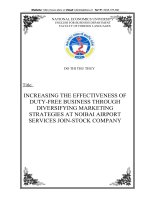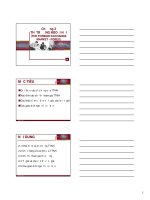Foreign Exchange Hedging Strategies at General Motors Critique
Bạn đang xem bản rút gọn của tài liệu. Xem và tải ngay bản đầy đủ của tài liệu tại đây (442.37 KB, 7 trang )
Foreign Exchange Hedging Strategies at General Motors Critique
Luke Bennrubi
Britten Feldman
Hillary Felice
Drew Ferwalt
Overview
❏
Review important topics
❏
Discuss material covered well
❏
Cover material missed
GM Hedging Policies
q
q
q
q
Commercial (Operating) Exposure: Volatile currencies
are hedged for only 6 months and risk threshold
lowered to $5 million from $10 million
Commercial (Capital) Exposure: Amounts in excess of
$1 million not $10 million (typo)
Accounting Policies: Held gains and losses from
hedging in shareholder’s equity account
Reporting: Hedging activities closely tracked; policy lead
to passive switch
GM Hedging Policy Objectives
❏
Reduce cash flow and earnings volatility
❏
Minimize the management time and costs dedicated to global FX management
❏
Align FX management in a manner consistent with how GM operates its automotive business
Passive vs. Active Hedging
❏ Currency exposure is inevitable when doing
business in foreign markets
❏ Passive Hedging
❏ Uses forward/options contracts (0-100%)
❏ Protects against exchange rate volatility
❏ Active Hedging
❏ Managers exploit inefficiencies in market
❏ Fundamental, technical, dynamic, option-based
“The second objective was a consequence of an internal study that determined
that investment of resources in active FX (foreign exchange) management had
not resulted in significant outperformance of passive benchmarks.”
Transactional Exposure
❏ Definition: Gains and losses when transactions
are settled in currency other than reporting
currency
❏ Stem from many different things
❏
❏
❏
Buying activities
Selling activities
Financing decisions (borrowing)
Translational Exposures
❏
❏
❏
Definition: Gains and losses that arise when assets and liabilities are translated back into
reporting currency
Determined by functional currency
GM does not hedge translational exposures
❏
Generally not large enough
❏
When large enough, senior finance executives
are notified









